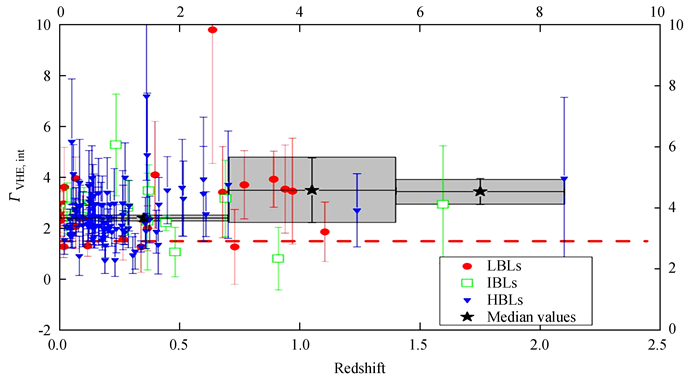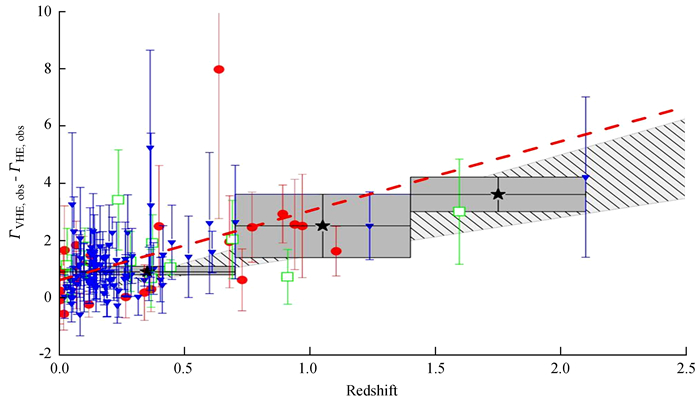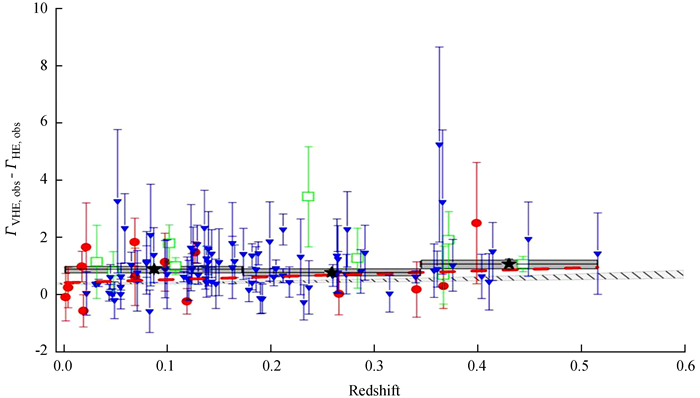2. 云南省高校高能天体物理重点实验室, 云南 昆明 650500
2. The Key Laboratory of the High Energy Astrophysics of University of Yunnan Province of China, Kunming 650500, China
BL Lac天体的连续辐射主要来自与观测者视线夹角很小的喷流辐射区,能谱分布呈双峰结构,对应两个主要辐射成分[1-2]。一般认为第1个峰(低能峰)是由极端相对论性电子同步辐射产生,第2个峰(高能峰)可能由相对论性电子的逆康普顿产生[3],也可能由相对论性质子同步辐射、光介子对级联过程、介子同步辐射等过程产生[4-5]。这两个主要辐射成分使伽玛射线谱带平滑,然而,在更高的能段,能谱分布图有变陡的趋势[6-7],这种趋势展示了不同能带间的能谱拐折。
宇宙中存在弥散河外星系背景光, 它是从紫外到远红外波的各向同性的弥散辐射场[8]。BL Lac天体喷流辐射区内产生的甚高能(E ≥ 50 GeV)伽玛射线光子在星际空间传播过程中与河外星系背景光子相互作用产生正负电子对[9-12],即γVHE+γEBL→e++e-,使得观测光谱变陡[13-14]。预计当TeV光子处于较高红移,具有明显的河外星系背景光吸收特性[12, 15-17]。然而,大红移BL Lac天体的伽玛射线辐射不能被次级级联[18-20]或轴子类型的粒子转换①吸收。基于上述情况,预计BL Lac天体的高能(100 MeV ≤ E<50 GeV)观测光谱和甚高能观测光谱是不同的,将导致GeV谱和TeV谱指数的不同。
为了阐明能谱拐折机制,本文主要研究了BL Lac天体GeV-TeV能谱指数,目的是确定河外星系背景光吸收是否是导致大红移BL Lac天体能谱拐折的主要原因。由于观测光谱是光谱被河外星系背景光吸收后得到的,因此对观测光谱进行修正可得到内禀光谱。
① https://arxiv.org/abs/1201.4711
1 样本选择本文选择Fermi-LAT 2FHL目录②和TeV目录③的源进行分析研究。2FHL目录包括甚高能观测谱指数和内禀谱指数,高能观测谱指数来自3FGL目录[21]。TeV目录包括甚高能和高能观测谱指数,但甚高能内禀谱指数来自文[22]。由于TeV目录中的某些源与2FHL目录中的源是相同的,因此对这些源仅计算一次。
② http://fermi.gsfc.nasa.gov/ssc/data/access/lat/2FHL/
耀变体分为BL Lac天体[23]和平谱射电类星体(FSRQs)[24]。与BL Lac天体相比,平谱射电类星体的宽线区的吸收和外部康普顿辐射将影响能谱拐折, 因此移除平谱射电类星体。从上述目录中选取126个观测谱指数(ΓVHE, obs)和内禀谱指数(ΓVHE, int),其中高能段有120个源。对于高能段的源,使用高能谱指数(ΓHE)完善数据。根据同步辐射峰值频率,将样本分为23个低同步辐射峰值频率BL Lac天体(νpeakS≤1014 Hz),13个中同步辐射峰值频率BL Lac天体(1014 Hz≤νpeakS≤1015 Hz),90个高同步辐射峰值频率BL Lac天体(νpeakS≥1015 Hz)。
2 观测谱和内禀谱的比较观测谱指数和内禀谱指数的分布如图 1。为了估计样本的最大似然均值和离散程度,按照如下方程组[25]:
| $ {\mathit{\Gamma }_0}{\rm{ = }}\left( {\frac{{{\mathit{\Gamma }_j}}}{{\sigma _0^2 + \sigma _j^2}}} \right){\left( {\sum\limits_{j = 1}^N {\frac{1}{{\sigma _0^2 + \sigma _j^2}}} } \right)^{ - 1}}, $ | (1) |
| $ \sum\limits_{j = 1}^N {\frac{1}{{\sigma _0^2 + \sigma _j^2}}} = \sum\limits_{j = 1}^N {\frac{{\left( {{\mathit{\Gamma }_j} - {\mathit{\Gamma }_0}} \right)}}{{{{\left( {\sigma _0^2 + \sigma _j^2} \right)}^2}}}.} $ | (2) |

|
| 图 1 观测谱指数与内禀谱指数的分布。观测谱指数分布由灰色直方图表示,内禀谱指数由阴影直方图表示。均值观测谱指数用灰色垂直虚线绘制,均值内禀谱指数由黑色垂直虚线绘制,它们通过文[25]的方法获得 Figure 1 The observed intrinsic spectral indices versus the intrinsic spectral indices. As shown in the figure, the observed spectral indices are represented by the gray histogram, the intrinsic spectral indices are represented by the shadow histogram. The mean observed spectral index is plotted by the gray vertical dotted line and the mean intrinsic spectral index is plotted by the black vertical dotted line, they are obtained by the method of the Venters & Pavlidou (2007)[25] |
其中,Γj为耀变体的谱指数;σj为谱指数的误差;N为总的耀变体数目;Γ0为均值谱指数;σ0为耀变体的离散程度。解上述方程组得到均值谱指数和离散程度,并将均值谱指数在图 1中表示。
通过计算,得到观测谱指数的离散程度σ0, obs=1.43和内禀谱指数的离散程度σ0, int=1.55。注意到σ0, int-σ0, obs=0.12,意味着观测谱指数和内禀谱指数的置信区间相差不大,不影响内禀谱指数和观测谱指数的研究。因为内禀谱(光谱未被河外星系背景光吸收)是通过观测谱修正得到的,预计内禀谱指数比观测谱指数小。如图 1,均值观测谱指数Γ0, obs=2.96,均值内禀谱指数Γ0, int=2.55。比较这两个值发现,均值观测谱指数相对较低,暗示着内禀谱是硬谱,而河外星系背景光修正的主要作用是减小均值谱指数。
甚高能内禀谱指数随红移的变化如图 2。由于内禀谱是河外星系背景光未吸收的光谱,河外星系背景光吸收的影响被移除。从图 2可以看出,样本的内禀谱指数没有随红移演化。这些源的中位数(黑色五角星)及其不确定度如图 2,中位数的不确定度是根据源每个红移区间的分布估计的,并且对各个中位数的不确定性解释。同样,文[22]和文[26]认为耀变体辐射的甚高能伽玛射线与河外星系背景光吸收相互作用产生正负电子对。在这种情况下,伽玛射线光谱预计比1.5软(即Γint≥1.5),它使内禀谱直接将观测谱与河外星系背景光吸收相联系, 因此可以看到一个水平直线Γint=1.5,当谱指数小于标准值(1.5),这个谱可能是最硬的谱。样本中大部分的源在1σ内,指数在图 2中大多超过1.5。

|
| 图 2 甚高能内禀谱指数随红移的演变。图中,实心红点表示LBL天体,绿色空心正方形表示IBL天体,实心蓝色三角形表示HBL天体。源的误差来自Fermi-LAT望远镜、H.E.S.S望远镜或MAGIC望远镜。实心黑色五边形代表每个红移区间内源的中位数(这里分为3个红移区间),中位数的1σ不确定度由灰色绘制。根据分析,源几乎比1.5软,这个下限用红色水平线绘制 Figure 2 The evolution of very high energy intrinsic spectral indices and redshift. As shown above, solid red dots represent LBL objects, green squares represent IBL objects, and solid blue triangles represent HBL objects. The error is derived from the Fermi-LAT telescope, H.E.S.S telescope or MAGIC telescope. The solid black pentagon represents the median of sources within each redshift bin (i.e., we can get three redshift bins), the 1σ uncertainties of the median are plotted by the gray box. According to our analysis, our sources are nearly softer than 1.5, and this lower limit is plotted by a red horizontal line |
通常,观测的高能谱(HE,100 MeV ≤ E<50 GeV)可以通过dN/dE∝E-ΓHE, obs的幂律谱拟合,观测的甚高能谱可以通过dN/dE∝E-ΓVHE, obs的幂律谱拟合,其中,ΓHE, obs和ΓVHE, obs分别是高能段和甚高能段的观测谱指数。在这些情况下,假设每个BL Lac天体的内禀谱在高能段用dN/dE∝E-ΓHE, int拟合,在甚高能段用dN/dE∝E-ΓVHE, int拟合,其中ΓHE, int,ΓVHE, int分别是在高能和甚高能的内禀谱指数。由于甚高能伽玛射线光子被河外星系背景光吸收,预计在测量中有明显的能谱拐折是河外星系背景光吸收导致的[13]。根据上述分析,导出ΓHE, obs=ΓHE, int和ΓVHE, obs=ΓVHE, int+ ΔΓEBL(E, z)两个关系。由于河外星系背景光吸收随红移线性变化,预计ΔΓEBL(E, z)=αz。
为了验证ΔΓEBL(E, z)=αz是否成立,首先研究河外星系背景光模型。由于不同的河外星系背景光模型可能导致ΔΓEBL(E, z)的变化。根据文[27-28]得到的所有河外星系背景光模型能谱:
| $ \frac{{{\rm{d}}N}}{{{\rm{d}}{E_{{\mathop{\rm int}} }}}} = \frac{{{\rm{d}}N}}{{{\rm{d}}{E_{{\rm{obs}}}}}}{e^{{\tau _{\gamma \gamma }}\left( {E,z} \right)}}, $ | (3) |
其中,τγγ(E, z)为光谱的光深。对(3)式做以下研究:
(1) 当E ≤ 0.1 TeV时,根据电子对产生过程[29-30]可知,τγγ(E, z)=0。在这种情况下,河外星系背景光模型的选择不影响研究。
(2) 当E>0.1 TeV时, τγγ(E, z)≠0,这意味着能谱已被吸收。但是当200 GeV ≤ E ≤ 10 TeV时,对于不同经验方法得到的3种河外星系背景光模型来说,τγγ(E, z)相差不大[12, 31-32],这表明河外星系背景光(Extragalactic Background Light, EBL)模型对研究的影响不大。
基于上述分析,研究能段小于10 TeV,意味着目前的河外星系背景光模型对研究的结果影响较小。在这种情况下,仔细研究河外星系背景光吸收与红移之间的关系,注意河外星系背景光吸收可以由甚高能观测谱指数和内禀谱指数之差(ΓVHE, obs-ΓVHE, int)代替。图 3绘制了河外星系背景光吸收随红移的演变。通过线性回归ΔΓEBL(E, z)=(1.83 ± 0.14)z + (0.08 ± 0.02)表示它们之间的关系。注意α=1.83 ± 0.14≠0,β=0.08 ± 0.02≈0,这明显展示了河外星系背景光吸收的性质(无耀变体的物理性质)。它们满足ΔΓEBL(E, z)=αz的相关性,并且在低红移区间河外星系背景光吸收的影响较小。

|
| 图 3 甚高能观测和内禀谱指数之间的差值随红移的变化。根据等式ΔΓEBL(E, z)=ΓVHE, obs-ΓVHE, int,只有河外星系背景光吸收的影响。这些源的框、符号和颜色绘制与图 2相同 Figure 3 The difference between the observed and intrinsic spectral indices at VHEs with redshift. According to the equation, ΔΓEBL(E, z)=ΓVHE, obs-ΓVHE, int, there is only the EBL attenuation which can affects this relationship. The boxes, symbols and colors of those sources are plotted same as Figure 2 |
基于上述分析,甚高能观测谱指数减去高能观测谱指数得到观测谱拐折,即ΔΓobs=ΓVHE, obs-ΓHE, obs。同样地,甚高能与高能内禀谱指数之间的差导出内禀谱拐折,ΔΓint=ΓVHE, int-ΓHE, int。这样可以看到观测谱拐折随红移的演化,也就是说,ΔΓobs=ΓVHE, int-ΓHE, int+ ΔΓEBL(E, z)=ΔΓEBL(E, z)+ΔΓint=αz+β,其中,预计ΔΓint=β,β与内禀谱曲率有关。与之相对,整个样本的最佳拟合线为ΔΓobs=(2.42 ± 0.38)z + (0.62 ± 0.17),注意α=2.42 ± 0.38≠0和β=0.62 ± 0.17≠0,与数学模型一致。可以得到观测能谱的拐折与河外星系背景光吸收和内禀光谱曲率(其他物理过程)有关。红移越高,观测光谱的拐折越明显,这意味着河外星系背景光吸收对处于低红移的源影响不大。
可以从理论模型的角度确定河外星系背景光吸收是否是导致大红移BL Lac天体能谱拐折的主要原因。在研究拐折的起源之前,认识内禀谱曲率十分重要,它可以由峰值频率前后之间的谱指数之差代替[33]。结合伽玛射线辐射的河外星系背景光吸收,这个曲率的最终表达式变得与ΔΓobs=ΓVHE, obs-ΓHE, obs一致。根据上述分析,只需从理论模型的角度得到最终曲率和红移之间关系。选择截断幂律自康普顿辐射模型[34]和河外背景光模型[4]模拟BL Lac天体的能谱分布。同样地,文[35-36]通过相同的模型证明了他们的分析。根据上述分析,在图 4中可得到一个灰色阴影条带,这个条带包括了河外星系背景光吸收、内禀光谱曲率及其误差。结合样本数据和数学模型,这个条带也证明了河外星系背景光吸收的影响不能被排除。

|
| 图 4 观测谱拐折与红移的关系。其误差是甚高能和高能观测谱指数的误差之和,图上的框、符号和颜色的绘制与图 2相同。根据数学模型ΔΓobs=αz + β,可以得到一条红色虚线。灰色阴影包含了内禀谱曲率,曲率误差和EBL吸收。注:红移越大,观测能谱拐折越明显。 Figure 4 The relationship between the observed spectra break and redshift for the full sample. The error-bars are the sum of the errors of the VHE and HE observed spectral indices, but the boxes, symbols and colors of others are plotted by the same method as figure 2. According to our math model, ΔΓobs=αz + β, we can get a red-dot line. The gray shadow includes the intrinsic spectral curvature, the error of curvature and EBL attenuation clearly. Note that the observed spectral break is more obvious in the higher redshift |
虽然在0 ≤ z ≤ 2.1区间内观测谱拐折的起源得到很好的证实,但是并不知道是否在较小的红移区间也能被证实。研究较小的红移区间内BL Lac天体的河外星系背景光吸收变得十分重要。根据源的分布情况,选择红移小于0.6区间,减少源选择误差。对于z ≤ 0.6的子样本如图 5,最佳拟合线为ΔΓobs=(1.04 ± 0.07)z + (0.42 ± 0.37),注意,α=1.04 ± 0.07≠0和β=0.42 ± 0.37≠0,它们与上述分析一致。使用相同的方法获得灰色阴影带,发现河外星系背景光吸收和内禀光谱曲率在低红移区间也发挥重要作用。结合整个样本的分析发现,源位于较高的红移中,观测能谱拐折更加明显。
基于观测能谱拐折的分析,有必要确定ΔΓint是否等于β。将研究甚高能内禀谱指数和高能观测谱指数之间的差异(即ΓVHE, int-ΓHE, obs,也称为内禀谱拐折)与红移之间的关系表示在图 6中。由于ΓHE, obs=ΓHE, int,并且内禀光谱如图 4是没有河外星系背景光吸收的光谱,因此内禀谱拐折移除了河外星系背景光吸收的影响。在图中没看到内禀谱拐折随红移的变化。在这种情况下,利用同步自康普顿散射(Synchrotron Self Compton Emission, SSC)模型拟合得到灰色阴影条带,这个灰色阴影带满足ΔΓint=β。结合这些方法发现,α=0而β≠0,表明河外星系背景光吸收不影响内禀能谱拐折,除了其他物理过程(内禀光谱曲率)。

|
| 图 6 甚高能内禀谱指数与高能谱指数之差随红移的演变。河外星系背景光吸收已被内禀谱拐折的特性所排除,只有耀变体物理(内禀谱曲率)才能影响这种关系。灰色阴影条带与数学模型ΔΓint=β一致。图中的框、符号和颜色与图 2相同 Figure 6 The difference between relationship between the intrinsic spectral index at VHEs and spectral index at HEs evolve with redshift. The EBL attenuation has been excluded by the property of the intrinsic spectral break, only the blazar physics (intrinsic spectral curvature) can affect this relationship. The gray shadow band has a consistent with math model, ΔΓint=β. The boxes, symbols and colors of those sources are plotted same as Figure 2 |
本文收集了126个大红移BL Lac天体GeV-TeV能谱指数,分析伽玛射线辐射的观测光谱和内禀光谱。分析发现:观测谱指数和内禀谱指数的离散程度只有微小的差异(即,观测光谱σ0, obs=1.43;内禀光谱σ0, int=1.55;两个分布的置信区间相似),但均值观测谱指数明显高于均值内禀谱指数(观测光谱Γ0, obs=2.96;内禀光谱Γ0, int=2.55),这意味着内禀光谱是一个硬谱,而且观测光谱被河外星系背景光吸收使均值光谱指数降低。
本文主要讨论观测能谱拐折和红移之间的关系,利用一个数学模型ΔΓobs=αz + β。对于这个数学模型,有下列3种情况:
(1) 当α≠0而β=0时,方程可以用河外星系背景光吸收与红移之间的关系代替,ΔΓEBL(E, z)=ΓVHE, obs-ΓVHE, int,这不是观测能谱的拐折。在这种情况下,发现样本数据与线性回归结果一致,这也表明河外星系背景光吸收对低红移的源影响较小。
(2) 当α≠0,β≠0时,ΔΓobs=αz + β是最终方程,这是观测能谱拐折。利用线性回归和同步自康普顿散射模拟、河外星系背景光模型验证发现,样本数据与这些方法得到的结果一致。由于α≠0,河外星系背景光吸收的影响不能被移除,而β≠0时, 内禀曲率的影响也不能被移除。
(3) 当α=0而β≠0时,该方程涉及甚高能内禀谱指数与高能观测谱指数的差,即ΔΓint=ΓVHE, int-ΓHE, obs。在这种情况下讨论的是内禀谱拐折,而河外星系背景光吸收的特性已移除。从内禀谱拐折的分布和理论模型模拟,得出内禀谱曲率(其它物理过程)可以影响这种关系。
得到统计结果α=2.42 ± 0.38≠0,β=0.62 ± 0.17≠0,这表明河外星系背景光吸收和其它一些物理过程在观测能谱拐折中起重要作用。同时也验证了河外星系背景光吸收是大红移BL Lac天体能谱拐折的主要因素之一。
已经验证河外星系背景光吸收是大红移BL Lac天体能谱拐折的主要因素之一,但是根据统计结果β≠0,说明能谱拐折还与β有关,需要对β进行讨论。对于能谱分布的拟合有很多不同的方法,文[14]利用对数抛物线同步自康普顿散射模型获得内禀谱曲率,但本文利用截断幂律同步自康普顿散射模型获取。不同的方法得到不同的电子谱,也使内禀谱曲率不同,从其它物理过程影响内禀谱拐折。主要研究能谱拐折,文[11, 37]认为观测能谱拐折随红移的演变包括了耀变体的物理性质和河外星系背景光吸收。但文[18]认为,光谱拐折可验证次级成分存在的假说。在样本研究中存在部分硬谱,预计宇宙射线质子与河外星系背景光子相互作用产生二次伽玛射线成分,也可以解释为高能伽玛光子在源附近震荡产生轴子类型粒子,在到达观测者前又转化为伽玛光子[19]。
| [1] | Paggi A. Flares in Blazars[D]. Roma: Universitá degli Studi di Roma, 2009. |
| [2] |
毛李胜. 费米BL Lac天体的中红外-伽马波段辐射相关性(英文)[J]. 天文研究与技术——国家天文台台刊, 2013, 10(2): 103–109 Mao Lisheng. Revisiting the correlation between γ-ray and Mid-Infrared Fluxes of the BL Lac objects detected by the FERMI satellite[J]. Astronomical Research & Technology——Publications of National Astronomical Observatories of China, 2013, 10(2): 103–109. |
| [3] | Maraschi L, Ghisellini G, Celotti A. A jet model for the gamma-ray emitting blazar 3C 279[J]. The Astrophysical Journal, 1992, 397: L5–L9. DOI: 10.1086/186531 |
| [4] | Dwek E, Krennrich F. Simultaneous constraints on the spectrum of the extragalactic background light and the intrinsic TeV spectra of Markarian 421, Markarian 501, and H1426+428[J]. The Astrophysical Journal, 2005, 618(2): 657–674. DOI: 10.1086/apj.2005.618.issue-2 |
| [5] | Sikora M, Begelman M C, Rees M J. Comptonization of diffuse ambient radiation by a relativistic jet:the source of gamma rays from blazars?[J]. The Astrophysical Journal, 1994, 421: 153–162. DOI: 10.1086/173633 |
| [6] | Abdo A A, Ackermann M, Ajello M, et al. Early Fermi Gamma-ray Space Telescope observations of the quasar 3C 454.3[J]. The Astrophysical Journal, 2009, 699(1): 817–823. DOI: 10.1088/0004-637X/699/1/817 |
| [7] | Abdo A A, Ackermann M, Ajello M, et al. Fermi Gamma-ray Space Telescope observations of the Gamma-ray outburst from 3C454.3 in November 2010[J]. The Astrophysical Journal Letters, 2011, 733(2): L26–L32. DOI: 10.1088/2041-8205/733/2/L26 |
| [8] | Hauser M G, Dwek E. The cosmic infrared background:measurements and implications 1[J]. Annual Review of Astronomy and Astrophysics, 2001, 39(1): 249–307. DOI: 10.1146/annurev.astro.39.1.249 |
| [9] | Stecker F W, De Jager O C, Salamon M H. TeV gamma rays from 3C 279-A possible probe of origin and intergalactic infrared radiation fields[J]. The Astrophysical Journal, 1992, 390: L49–L52. DOI: 10.1086/186369 |
| [10] | Stecker F W, Jager O C D. Absorption of very high energy Gamma-rays by intergalactic infrared radiation:a new determination[J]. Astronomy & Astrophysics, 1998, 334(3): L85–L87. |
| [11] | Stecker F W, Malkan M A, Scully S T. Intergalactic photon spectra from the far-IR to the UV Lyman limit for 0 < z < 6 and the optical depth of the universe to high-energy gamma rays[J]. The Astrophysical Journal, 2006, 648: 774–783. DOI: 10.1086/apj.2006.648.issue-2 |
| [12] | Franceschini A, Rodighiero G, Vaccari M. Extragalactic optical-infrared background radiation, its time evolution and the cosmic photon-photon opacity[J]. Astronomy & Astrophysics, 2008, 487(3): 837–852. |
| [13] | Ackermann M, Ajello M, Allafort A, et al. The imprint of the extragalactic background light in the gamma-ray spectra of blazars[J]. Science, 2012, 338(6111): 1190–1192. DOI: 10.1126/science.1227160 |
| [14] | Sanchez D A, Fegan S, Giebels B. Evidence for a cosmological effect in γ-ray spectra of BL Lacertae[J]. Astronomy & Astrophysics, 2013, 554: A75–A83. |
| [15] | Kneiske T M, Bretz T, Mannheim K, et al. Implications of cosmological gamma-ray absorption-Ⅱ. Modification of gamma-ray spectra[J]. Astronomy & Astrophysics, 2004, 413(3): 807–815. |
| [16] | Imran A, Krennrich F. Detecting a unique EBL signature with TeV gamma rays[C]//International Cosmic Ray Conference. 2007: 981-984. |
| [17] | Tavecchio F, Mazin D. Intrinsic absorption in 3C 279 at GeV-TeV energies and consequences for estimates of the extragalactic background light[J]. Monthly Notices of the Royal Astronomical Society:Letters, 2009, 392(1): L40–L44. DOI: 10.1111/mnl.2008.392.issue-1 |
| [18] | Essey W, Kusenko A. On weak redshift dependence of gamma-ray spectra of distant blazars[J]. The Astrophysical Journal Letters, 2012, 751(1): L11–L14. DOI: 10.1088/2041-8205/751/1/L11 |
| [19] | Zheng Y G, Kang T. Evidence for secondary emission as the origin of hard spectra in TeV blazars[J]. The Astrophysical Journal, 2013, 764(2): 113–117. DOI: 10.1088/0004-637X/764/2/113 |
| [20] | Zheng Y G, Yang C Y, Kang S J. Bethe-Heitler cascades as a plausible origin of hard spectra in distant TeV blazars[J]. Astronomy & Astrophysics, 2016, 585: A8–A15. |
| [21] | Acero F, Ackermann M, Ajello M, et al. Fermi large area telescope third source catalog[J]. The Astrophysical Journal Supplement Series, 2015, 218(2): 23–63. DOI: 10.1088/0067-0049/218/2/23 |
| [22] | Gilmore R C, Somerville R S, Primack J R, et al. Semi-analytic modelling of the extragalactic background light and consequences for extragalactic gamma-ray spectra[J]. Monthly Notices of the Royal Astronomical Society, 2012, 422(4): 3189–3207. DOI: 10.1111/mnr.2012.422.issue-4 |
| [23] |
白金明. BL Lac天体的光变[J]. 天文台台刊, 2000(1): 58–60 Bai J. Variability in the BL Lac objects[J]. Publications of Yunnan Observatory, 2000(1): 58–60. |
| [24] |
米立功, 崔朗, 胡开宇. 59个耀变体的15.3GHz光变周期分析[J]. 天文研究与技术, 2015, 12(4): 410–416 Mi Ligong, Cui Lang, Hu Kaiyu. An analysis of periods of light variations of 59 blazars observed at 15.3GHz[J]. Astronomical Research & Technology, 2015, 12(4): 410–416. |
| [25] | Venters T M, Pavlidou V. The spectral index distribution of EGRET blazars:prospects for GLAST[J]. The Astrophysical Journal, 2007, 666(1): 128–138. DOI: 10.1086/509299 |
| [26] | Aharonian F, Akhperjanian A G, Bazer-Bachi A R, et al. A low level of extragalactic background light as revealed by gamma-rays from blazars.[J]. Nature, 2006, 440(7087): 1018–1021. DOI: 10.1038/nature04680 |
| [27] | Albert J, Aliu E, Anderhub H, et al. Observation of very high energy γ-rays from the AGN 1ES 2344+514 in a low emission state with the MAGIC telescope[J]. The Astrophysical Journal, 2007, 662(2): 892–899. DOI: 10.1086/509292 |
| [28] | Raue M, Mazin D. Optical depth for VHE γ-rays from distant sources from a generic EBL density[J]. International Journal of Modern Physics D, 2008, 17(9): 1515–1520. DOI: 10.1142/S0218271808013091 |
| [29] | Rubtsov G I, Troitsky S V. Breaks in gamma-ray spectra of distant blazars and transparency of the Universe[J]. JETP Letters, 2014, 100(6): 355–359. DOI: 10.1134/S0021364014180088 |
| [30] | Dzhatdoev T A. On conservative models of "the pair-production anomaly" in blazar spectra at Very High Energies[C]//Journal of Physics: Conference Series. 2015. |
| [31] | Dominguez A, Primack J R, Rosario D J, et al. Extragalactic background light inferred from AEGIS galaxy-SED-type fractions[J]. Monthly Notices of the Royal Astronomical Society, 2011, 410(4): 2556–2578. DOI: 10.1111/j.1365-2966.2010.17631.x |
| [32] | Finke J D, Razzaque S, Dermer C D. Modeling the extragalactic background light from stars and dust[J]. The Astrophysical Journal, 2010, 712(1): 238–249. DOI: 10.1088/0004-637X/712/1/238 |
| [33] | Chen L. Curvature of the spectral energy distributions of blazars[J]. The Astrophysical Journal, 2014, 788(2): 179–194. DOI: 10.1088/0004-637X/788/2/179 |
| [34] | Massaro F. Spectral evolution of the high energy emission from TeV BL Lac Objects[D]. Roma: Universitá degli Studi di Roma, 2008. |
| [35] | Albert J, Aliu E, Anderhub H, et al. Discovery of Very High Energy γ-Rays from 1ES 1011+496 at z=0.212[J]. The Astrophysical Journal Letters, 2007, 667(1): L21–L24. DOI: 10.1086/521982 |
| [36] | Aharonian F, Akhperjanian A G, De Almeida U B, et al. Discovery of VHE gamma-rays from the distant BL Lacertae 1ES 0347-121[J]. Astronomy & Astrophysics, 2007, 473(3): L25–L28. |
| [37] | Stecker F W, Scully S T. Derivation of a relation for the steepening of Tev-selected blazar γ-ray spectra with energy and redshift[J]. The Astrophysical Journal Letters, 2010, 709(2): L124–L126. DOI: 10.1088/2041-8205/709/2/L124 |




